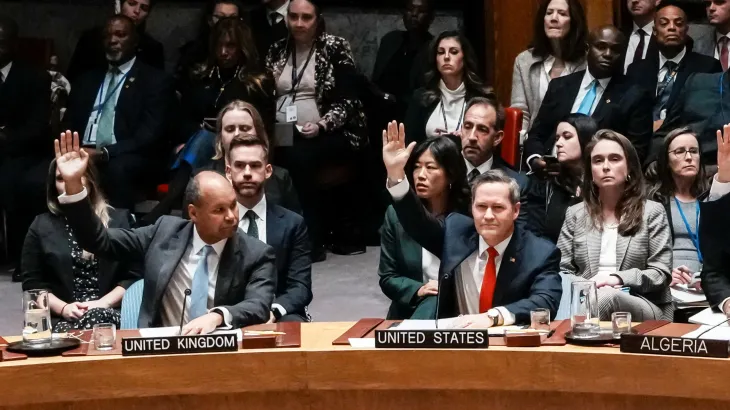UN Adopts Trump’s Gaza Plan: A Full Breakdown of the New Post-War Framework

The UN Security Council approved a revised US resolution on Monday night that supports President Donald Trump’s plan to end the war in Gaza. Thirteen members voted in favor. Russia and China abstained. They did not use their veto power. The resolutionو , at least on paper, calls for full implementation of the plan and for maintaining the ceasefire.
This explainer breaks down what the resolution includes, why the Palestinians refuse it, and what it could mean for Gaza’s future.
What’s in Trump’s Resolution?
Resolution 2803 endorses Trump’s 20-point plan to end the war in Gaza. The US issued this plan on September 29, 2025. The resolution builds a full administrative and security framework for the post-war phase.
Here are the key points:
1. Full approval of Trump’s Gaza plan.
The resolution adopts the entire 20-point framework and urges all sides to implement it without delay.
2. Creation of a “Peace Council.”
This new transitional body will oversee Gaza’s reconstruction. It will have international legal status. The text adds that the council must operate under international law.
3. Conditions for Palestinian self-determination.
The resolution says ‘reforming’ the Palestinian Authority and making progress in reconstruction could create conditions for a future path toward self-determination and statehood. The US will open political dialogue with the parties.
4. Humanitarian aid resumption.
Aid must enter Gaza again in coordination with the Peace Council. The resolution stresses that aid must only be used for civilian purposes.
5. Creation of international operational bodies.
The Peace Council and participating states can create bodies with international authority to run transitional governance, reconstruction, services, and border crossings.
6. International funding push.
The resolution invites the World Bank and other financial institutions to help rebuild Gaza and create a dedicated reconstruction fund.
7. International Stabilization Force.
A temporary force will deploy in Gaza under a unified command accepted by the Peace Council, and coordinated with Egypt and Israel. The force can use all necessary measures under international law.
8. Mission of the force.
It will:
– Remove weapons from Gaza
– Protect civilians
– Train Palestinian police
– Secure humanitarian corridors
– Monitor the ceasefire
– Support the Peace Council’s work
9. Israeli withdrawal.
As the international force gains control, Israeli troops will withdraw according to a negotiated timetable and conditions.
10. End date.
The Peace Council and the international civilian and security presence will expire on December 31, 2027, unless the Council decides otherwise.
11. Support call.
States and organizations should offer financial and logistical support. The Peace Council must report every six months.
How Did Security Council Members Vote?
Thirteen members voted in favor. Russia and China abstained.
Russia’s position
Russia said it could not support a resolution that avoids committing to a two-state solution. Ambassador Vasily Nebenzya criticized the plan for excluding the Palestinian Authority and warned it may deepen Gaza-West Bank separation. He stressed that the setup is a colonial mandate that ignored Palestinian rights.
Nebenzya also questioned the scope of the international force, warning that disarmament roles would make it a party to the conflict.
China’s position
China said Gaza’s governance arrangements appear to exclude Palestinians. Ambassador Fu Cong warned that Palestinian sovereignty is not reflected in the plan and that the draft fails to reaffirm the global consensus on a two-state solution.
Fu argued that any post-war structure must respect Palestinian will and must give the Palestinian Authority a central role. He said the UN should manage reconstruction, but the resolution gives it no such mandate.
How Did Palestinians Respond?
Palestinian Authority
The PA welcomed the resolution. It said it is ready to take full responsibility for implementation. It called for:
– Protection of Palestinians
– Prevention of forced displacement
– Complete Israeli withdrawal
– Reconstruction
– Protection of the two-state framework
The PA also said it is ready to coordinate with the US, Security Council members, Arab and Islamic states, the EU, the UN, and other partners.
Hamas
Hamas rejected the resolution. The group said it does not meet Palestinian political and humanitarian demands. Hamas argued that the resolution creates foreign guardianship over Gaza and serves Israeli goals that the army could not achieve.
Hamas said the resolution separates Gaza from the rest of Palestinian land. It warned that disarmament tasks turn the international force into a side in the conflict, not a neutral actor.
Islamic Jihad
Islamic Jihad also rejected the resolution. It said the plan imposes international tutelage over Gaza and violates Palestinians’ right to resist occupation. The resistance group said resistance weapons are protected under international law. It criticized the use of humanitarian aid and border access as political pressure tools.
Other Palestinian factions
Several factions issued warnings before the vote. They said the plan threatens to impose external control over Gaza and to strip Palestinians of their right to manage their own affairs. They insisted that any discussion of weapons must be internal and tied to ending occupation and achieving statehood.
How Did Israel Respond?
Israeli reactions were divided.
Avigdor Lieberman said the decision shows failure by the Israeli government. He claimed the deal brings a Palestinian state, Saudi nuclear capabilities, and advanced jets for Turkey and Saudi Arabia, calling it a threat to Israel’s security.
Israel’s UN ambassador Danny Danon welcomed the focus on disarming Hamas. He said there will be no future for Gaza if Hamas retains weapons.
What Could This Resolution Mean for Gaza?
The resolution aims to stabilize the ceasefire, reopen humanitarian channels, and create a narrow path toward Palestinian statehood. But the road ahead is filled with obstacles.
– Palestinian resistance groups refuse to disarm without a state and an end to occupation.
– Key Israeli leaders reject commitments toward Palestinian statehood.
– Media reports say parts of Trump’s plan are uncomfortable for Israel.
As a result, implementation may face political deadlock on all sides.




